|
|
 |
|
Calanoida ( Order ) |
|
|
|
Diaptomoidea ( Superfamily ) |
|
|
|
Centropagidae ( Family ) |
|
|
|
Centropages ( Genus ) |
|
|
| |
Centropages brevifurcus Shen & Lee, 1963 (F,M) | |
| | | | | | | Ref.: | | | Shen & Lee, 1963 (p.575, 593, figs.F,M); Chen & Zhang, 1965 (p.75, 127: Rem.); Mulyadi, 1998 (p.55, Redescr.F,M, figs.F,M); Ohtsuka, McKinnon & al., 2003 (p.67, figs.F,M, Rem.); Mulyadi, 2004 (p.124, figs.F,M, Rem.) | 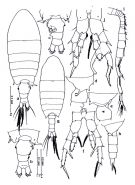 issued from : Mulyadi in The Raffles Bull. Zool., 1998, 46 (1). [Fig.2, p.57]. Female: a, habitus (dorsal view); b, Th5 and urosome (dorsal view); c, idem (lateral view); d-e, Th5 and genital complex (lateral view); f, P5. Male: g, habitus (dorsal view); h, Th5 and urosome (lateral view); i, right A1; j, P5. Nota: The present specimens differs from Shen & Lee (1963). Nota Female: Rostrum biramous with short filaments. A1 22-segmented, reacing distal end of last thoracic segment, number and relative lengths of basal segments not easily determined, apparently several segments fused together to form 2nd segment, segments 8 and 9, and 24 and 25 partially fusedPosterolateral ends of last thoracic segment produced into asymmetrical acute process on left side; right side produced into acute and curved process, each armed with 2 short spines situated rather toward ventral side; in lateral view, posterolateral ends trifurcate. Genital complex widest, asymmetrical, 1.3 times as long as urosomal segment 3, anterolateral swelling armed with spinules that extend to dorsal and ventral surfaces, right margin with distolateral knob-like process. Urosomal segment 2 asymmetrical, right margin with knob-like process medially. Anal somite almost symmetrical, expanded posteriorly, as long as caudal rami. Caudal rami symmetrical, divergent, 1.4 times as long as wide, with 5 plumose and 1 small setae. Nota Male: Posterolateral ends of last thoracic segment sharply pointed, symmetrical; each armed with 2 spinules situated rather toward ventral side; in lateral view, posterolateral ends trifurcate. A1 23-segmented. Urosomal segment 1 (genital somite) short, left side slightly produced posterolaterally, as long as urosomal segment 4. Urosomal segment 2 longest. Anal somite very short. Caudal rami as in female. Coxopodites of P5 with 1 small spine, basis with outer seta distally; right and left endopods very similar to those of the female.
|
 issued from : C.-j. Shen & F.-s. Lee in Acta zool. Sin., 1963, 15 (4). [p.576, Figs.11-14]. Female (from N Luichow Peninsula): 11, habitus (dorsal); 12, P5. Male: 13, habitus (dorsal); 14, P5.
|
 issued from : S. Ohtsuka, D. McKinnon, K. Pinkaew, S. Putchakarn & K. Chalermwat in Species Diversity, 2003, 8. [p.69, Figs.1]. Female (G. of Thailand): A, habitus (dorsal view); B, habitus (lateral view); C, Rostrum; D, fifth pediger and genital compound somite (lateral left view); E, fifth pediger and first two urosomites (lateral right view); F, fifth pediger and urosome (dorsal view); G, A1: first (I) to 14th (XVIII) segments; H, A1: 15th (XIX) to 21st (XXV) segments; I, A1: 22nd (XXVI-XXVII) segment; J, A2; J, Md; L, P5 (arrowed: swelling at outer distal corner of first endopodal segment). Scale bars in mm. Nota : Cephalosome with posterodorsal knob, and 1st pediger separate, 4th and 5th separate. 5th pediger asymmetrical at posterior corners, with 3 ventrolateral pairs of acutely pointed processes ; right dorsalmost process abruptly curved outward. Prosome about 2.8 times as long as urosome. Rostrum bearing pair of long filaments with broad bases. Urosome 3-segmented, bearing minute prominences dorsally (difficult to observe with light microscope). Genital compound somite asymmetrical, expanded anterolaterally, with 2 rows of spinules on right dorsolateral side ; patch of spinules on left dorsolateral side, and serration along posterodorsal margin. Genital operculum located ventrolaterally on right side, with right distal corner produced posteriorly into round or somewhat pointed process. 2nd urosomal somite with swelling ventrolaterally on right side ; posterior margin of swelling concave. Anal somite and caudal rami slightly asymmetrical. Caudal ramus about twice as long as wide ; caudal seta V longest of caudal setae. A1 22-segmented, reaching slightly beyond posterior margin of genital compound somite. A2 with coxa and basis incompletely fused, bearing 1 and 2 plumose setae, respectively. Endopod 2-segmented, 2nd segment bilobed, with proximal and distal lobes bearing 9 and 5 setae, rspectively. Exopod indistinctly 8-segmented with setal formula 2, 1, 1, 1, 1, 1, 1, 1 + 3. Md with 8 cusped teeth and 1 spinulose seta along coxal cutting edge. Endopod 2-segmented, 1st and 2nd segments bearing 4 and 9 setae, respectively ; 2nd segment with longitudinal row of spinules. Exopod 4-segmented with setal formula 1, 1, 1, 3.
|
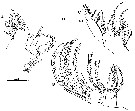 issued from : S. Ohtsuka, D. McKinnon, K. Pinkaew, S. Putchakarn & K. Chalermwat in Species Diversity, 2003, 8. [p.72, Fig.3].]. Female: A, Mx1; B, Mx2; C, Mxp. Scale bars in mm. Nota : Mx1 with 16 well-chitinized elements on praecoxal arthrite ; Coxal epipodite bearing 7 well developed and 2 short proximal setae and proximal patch of setules ; coxal endite with 3 setae ; basal exite with short seta ; 1st basal endite with 4 setae ; 2nd basal endite completely coalescent with endopod, represented by 5 setae ; endopod indistinctly 2-segmented , proximal and distal segments bearing 6 and 3 setae, respectively ; exopod bearing 9 setae and transverse row of minute spinules distally. Mx2 with praecoxal and coxal endites bearing 5, 3 and 3, 3 setae, respectively ; basal endite with 1 strong and 2 short, slender setae ; endopod 4-segmented with setal formula 2, 2, 2, 2 ; inner seta on 2nd endopodal segment rudimentary. Mxp with setal formula of syncoxa 1, 2, 3, 3 ; rudimentary praecoxal endite represented by minute seta ; basis with spinular row along ¾ of inner margin and 3 plumose setae subterminally ; endopod 6-segmented, 1st segment incompletely incorporated into basis, 2nd to 6th endopodal segments bearing 2, 3, 2, 2+1, and 4 setae, respectively.
|
 issued from : S. Ohtsuka, D. McKinnon, K. Pinkaew, S. Putchakarn & K. Chalermwat in Species Diversity, 2003, 8. [p. 73, Fig.4]. Female: A-D, P1 to P4 respectively; E, P5 (swelling at outer distal corner of 1st endopodal segment arrowed). Scale bars in mm. Nota : P5 symmetrical ; coxa with acutely pointed process near posterior margin on posterior surface ; 1st endopodal segment produced into round swelling at outer distal corner ; 2nd exopodal segment bearing thick inner process with serration along distal ¾ of posterior margin.
|
 issued from : S. Ohtsuka, D. McKinnon, K. Pinkaew, S. Putchakarn & K. Chalermwat in Species Diversity, 2003, 8. [p. 71, Table 1]. Female: Armature formula P1-P5 swimming legs. Spines = Roman numerals; setae = Arabic numerals.
|
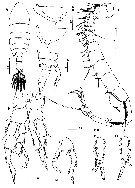 issued from : S. Ohtsuka, D. McKinnon, K. Pinkaew, S. Putchakarn & K. Chalermwat in Species Diversity, 2003, 8. [p.74, Fig.5]. Male (from G. of Thailand): A, habitus (dorsal view); B, fifth pediger (right lateral view); C, fifth pediger (left lateral view); D, 4th and 5th pedigers and urosome (right lateral view); E, right A1 (rudimentary setaarrowed); F, right third exopodal segment of P4 (distolateral spine arrowed); G, left third exopodal segment of P4 (distolateral spine arrowed); H, P5 (anterior view); I, second and third exopodal segments of right P5 (posterior view) Scales in mm. Nota : 5th pedigerous somite slightly asymmetrical, left corner more posteriorly produced than right ; posterior corners furnished with 3 pairs of processes ventrolaterally as in female, lateral one largest. Urosome 4-segmented. Right A1 geniculate, 22-segmented. 17th segment with serrate process along entire anterior margin and pointed tip slightly covering base of 18th segment (ancetral XX) ; 18th segment with finely serrate process and hollow groove along entire anterior margin ; 19th compound segment (ancestral XXI-XXIII) with 2 serrate proximal processes, rudimentary seta midlength, and short terminal process (not element ?) ; last compound segment with sharply poineted anterior process originating from segment XXVII, as long as penultimate segment. Mouthpart appendages and legs 1-3 similar to those of female. P4 asymmetrical, with right distolateral bidenticulate spine of 3rd exopodal segment larger than left one (arrowed in fig.5F,G). P5 with intercoxal sclerite bearing setules on anterior surface ; coxa with spiniform process subterminally on posterior surface ; basis bearing outer seta at anterior terminal corner ; 1st endopodal segment of both legs produced posterodistally into swelling with round tip as in female. Right leg with both rami 3-segmented ; 1st exopodal segment rectangular ; 2nd exopodal segment drawn inwards into curved process with 2-6 round outer swellings midway and triangular inner process suterminally ; 3rd exopodal segment recurved, bearinginner seta approximately at 1/7 length, sharply pointe douter process and minute inner prominence at midlength, and 2 rows of pointed prominences along outer distal half length (fig.6B) ; serrate distal half slightly swollen ventrally at midlength. Left leg with 3-segmented endopod and 2-segmented exopod ; 1st exopodal segment swollen proximomedially ; 2nd exopodal segment elongate, bearing 2 spines at tip (outer one approximately 4 times as long as inner one) and 2 outer spines.
|
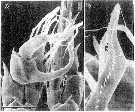 issued from : S. Ohtsuka, D. McKinnon, K. Pinkaew, S. Putchakarn & K. Chalermwat in Species Diversity, 2003, 8. [p.76, Fig.6]. Male (SEM micrographs): A, P5 (posterior view; arrow: outer distal expansion of 1st endopodal segment); B, distal part of 3rd exopodal segment of right P5. Scale bars: 0.1 mm (A); 0.01 mm (B).
|
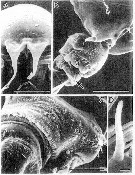 issued from : S. Ohtsuka, D. McKinnon, K. Pinkaew, S. Putchakarn & K. Chalermwat in Species Diversity, 2003, 8. [p.70, Fig.2]. Female (SEM micrographs): A, rostrum; B, 5th pediger, genital compound somite, and 2nd urosomite (ventrolateral view; g: genital operculum; arrow: ventrolateral process on 2nd urosomite); C, genital compound somite (dorsal view); D, inner expansion of 2nd exopodal segment of P5. Scale bars: 0.05 mm (A, C), 0.1 mm (B), 1.01 mm (D).
| | | | | Compl. Ref.: | | | Shih & Young, 1995 (p.69) | | | | NZ: | 2 | | |
|
Distribution map of Centropages brevifurcus by geographical zones
|
| | | | | | | Loc: | | | China Seas (South China Sea, Canton : Chiekong & Zaikong Rivers : estuaries), Indonesia-Malaysia (Java: off Labuan, Jakarta-Seribu Islands, off Tegal, off Surabaya), W Gulf of Thailand (Prachuap Khiri Khan) | | | | N: | 4 (Indonesia-Malaysia.: 3; Pacif.: 1) | | | | Lg.: | | | (351) F: 1,44; M: 1,25; (776) F: 1,38-1,27; M: 1,16-1,1; (902) F: 0,92-1,06; M: 0,78-0,92; (1122) F: 1,3; M: 1,1; {F: 0,92-1,44; M: 0,78-1,25} | | | | Rem.: | Perhaps a synonym of C. trispinosus.
For Ohtsuka & al. (2003, p.75), the body length, the posterior prosomal corner, and P5 of the female of C. trispinosus Sewell, 1914, are similar to those of female C. brevifurcus, but the 3rd exopodal segment of P5 is relatively much shorter in C. trispinosus (ca. 1.4 times as long as the 2nd segment) than in C. brevifurcus (1.7). In addition, the inner process of the 2nd endopodal segment of female P5 of C. trispinosus is slender and pointed at the apex and lacks serration along posterior margin. The genital compound somite carries a dorsal swelling only in C. trispinosus. Pending a complete redescription of both sexes, possibility cannot excluded that this species is identical to C. brevifurcus.
The shape and size of the three ventrolateral pairs of processes on the 5th pedigerous somite of both sexes vary somewhat among individuals. The right posterior process on the female genital operculum may be rounded or somewhat pointed at the tip. The asymmetry of male P4 was confirmed in all the specimens dissected. The number of outer swellings at midlength of the process on the 2nd exopodal segment of male P5 ranges between 2 and 6. | | | Last update : 31/12/2014 | |
|
|
 Any use of this site for a publication will be mentioned with the following reference : Any use of this site for a publication will be mentioned with the following reference :
Razouls C., Desreumaux N., Kouwenberg J. and de Bovée F., 2005-2025. - Biodiversity of Marine Planktonic Copepods (morphology, geographical distribution and biological data). Sorbonne University, CNRS. Available at http://copepodes.obs-banyuls.fr/en [Accessed August 18, 2025] © copyright 2005-2025 Sorbonne University, CNRS
|
|
 |
 |











